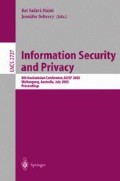Abstract
We deal with the revocation scheme such that the revoked receivers should not be able to obtain available information when a center broadcasts data to all receivers. We propose a new revocation scheme with minimal message length for stateless receivers, where the receivers do not update their state from session to session. The proposed scheme requires storage of 21 log2 n− 21 log n+2 keys at the receiver and a message length of at most r+1. The main contribution of the proposed scheme is to reduce the message length. Namely, the proposed scheme minimizes the number of subsets which the non-revoked receivers are partitioned.
This research was supported by University IT Research Center Project, the Brain Korea 21 Project, and Com2MaC-KOSEF.
Access this chapter
Tax calculation will be finalised at checkout
Purchases are for personal use only
Preview
Unable to display preview. Download preview PDF.
References
T. Asano, A Revocation Scheme with Minimal Storage at Receivers, Advances in Cryptology — ASIACRYPT’ 02, pp.433–450, 2002.
A. Fiat and M. Naor, Broadcast Encryption, Advances in Cryptology — CRYPTO’ 93, pp.480–491, 1994.
D. Halevy and A. Shamir, The LSD Broadcast Encryption Scheme, Advances in Cryptology — CRYPTO’ 02, pp.47–60, 2002.
A. Menezes, P. van Oorschot and S. Vanstone, Handbook of applied cryptography, CRC Press, Inc., 1997.
D. Naor, M. Naor and J. Lotspiech, Revocation and Tracing Schemes for Stateless Receivers, Advances in Cryptology — CRYPTO’ 01, pp.41–62, 2001
D. M. Wallner, E. J. Harder and R.C. Agee, Key Management for Multicast: Issues and Architectures, IETF Network Working Group, Request for Comments 2627, June, 1999. http://ftp.ietf.org/rfc/rfc2627.txt
C. K. Wong, M. Gouda and S. Lam, Secure Group Communications Using Key Graphs, Proceedings of ACM SIGCOMM’ 98, pp.68–79, 1998.
Author information
Authors and Affiliations
Editor information
Editors and Affiliations
Rights and permissions
Copyright information
© 2003 Springer-Verlag Berlin Heidelberg
About this paper
Cite this paper
Hwang, Y.H., Kim, C.H., Lee, P.J. (2003). An Efficient Revocation Scheme with Minimal Message Length for Stateless Receivers. In: Safavi-Naini, R., Seberry, J. (eds) Information Security and Privacy. ACISP 2003. Lecture Notes in Computer Science, vol 2727. Springer, Berlin, Heidelberg. https://doi.org/10.1007/3-540-45067-X_32
Download citation
DOI: https://doi.org/10.1007/3-540-45067-X_32
Published:
Publisher Name: Springer, Berlin, Heidelberg
Print ISBN: 978-3-540-40515-3
Online ISBN: 978-3-540-45067-2
eBook Packages: Springer Book Archive

